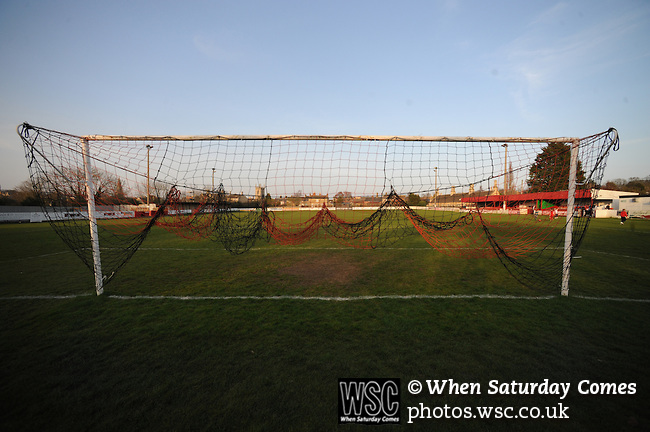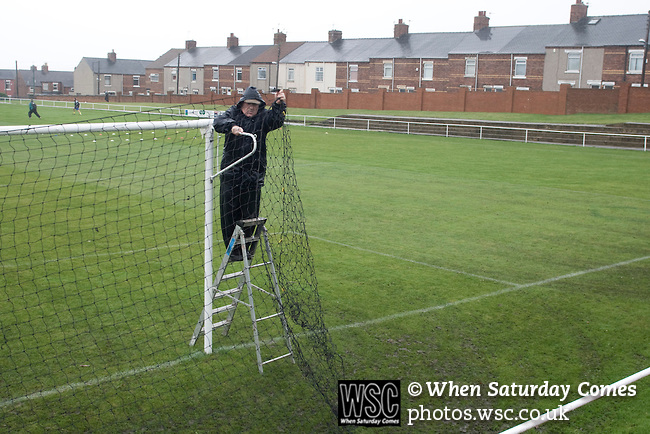
Most people keep quiet about their childhood fantasies. But not Olly Wicken in WSC 59, January 1992, who explained why goalnets were at the heart of football’s appeal
It may be a healthy passion or it may be a fetish. I’ll leave you to judge. But ever since a very young age I have had a strong interest in goalnets. Great big, bulging goalnets. I love them.
They do something for me: if ever I’m looking out from a train and I see a plain set of goalposts, I get a shiver of excitement; but if the nets are up, I’m clawing at the windows. I slaver and I yelp; I just want to get out there and test their breaking strain by spanking a twenty-five yarder into the top comer. Am I alone on this one? Or very alone?
Because although nets were initially introduced to football primarily for the mundane function of helping referees judge whether the ball had passed inside or outside the goalpost, for me, they adom the very heart of soccer’s appeal. Let me explain.
I think it all started at around the age of seven when my older brother and I used to play “three-and-in” in the back garden at home. Even though all we had to use as goalposts were cricket stumps, I used to imagine that there was a net: it added enormously to the fantasy of being Sepp Maier between the sticks. (My brother was bigger than me, so he always got to be Gordon Banks.)
Imagining the existence of a net made a big difference: at the very least I felt less inclined to worry about the usual props one would employ for total Sepp-simulation and therefore having to find Dad’s huge gardening gloves as well; but, at it’s most positive, the imaginary net transformed a mundane suburban kickabout into the high drama of goalmouth action in the heat and altitude of Mexico City; and whenever it was my turn out of goal it was Barry Endean who was rattling the rigging in the Aztec Stadium. Deep joy.
When it was my turn to be keeper, my movements in and around the goal always acknowledged the presence of a goalnet: whenever one of bruv’s left-footed piledrivers from across the rosebed thundered narrowly wide, I would always go to fetch the ball by walking around the goal. And whenever one of his deft chips from behind the magnolia went over my head (and he won the ensuing scuffle about whether or not it was a goal), I would always fetch the ball through the goal and disconsolately mime holding up the back of the goalnet when picking the ball out of the runner beans.
As a kid, I really aspired to goalnets. They symbolised proper football – the real thing. It was a source of unending disappointment that my primary school team played its home games with naked goalposts – it spoke volumes for the school’s meagre footballing ambitions.
Retrospectively, however, maybe our goalkeeper suffered the same excitement: perhaps the 0-16 and 0-12 defeats owed something to his own personal thrill at seeing the goalnet bulge at close quarters. Nevertheless, these were formative experiences: I think it was then that I first became enamoured with the noise a net makes when a goal was scored: that sharp scratching scudding sound of leather skidding to a halt against twine. Even today, just thinking about it gives me a tingle.
Inevitably, I suppose, as a child who enjoyed his “creative play” sessions at junior school, I soon turned my hand to trying to build my own goal complete with nets. Long hours were spent in the garden shed until my creation finally took shape: a wobbly concoction of bamboo canes and strawberry netting, it had no crossbar and its net was unrealistically taut along the goal-line.
Looking back now, the ingenious answer would have been to attach a triangular wire coathanger to the top of each cane to act as a stanchion. Now that would have been an idea. And if I’d thought to cover the whole thing in sticky-back plastic I might have got invited to take my invention onto Blue Peter and bang one past Lesley Judd high into the roof of the mesh.
But this is all wishful retrospective thinking – when bruv and I actually tested the shambolic construction, the first goalmouth melee we had left us wrapped in plastic netting, helplessly ensnared and virtually impaled upon the splintered bamboo. But even to this day I insist that the whole of the ball never crossed the line.
By the time I started going to watch League games, I was becoming something of a connoisseur of goalnets. As anyone who has ever scored a goal in a goalnet will know, it’s vital to one’s full satisfaction that the ball nestles in the net. It must make that sharp scratching scudding sound and then nestle, perhaps still slightly spinning, with the net flopping down over it.
If the ball only creeps over the line and doesn’t reach the net, if it’s kicked away from behind the line, or if it rebounds from an over-taut net, you get a sense of incompleteness, a sense that it wasn’t as good a goal as it could have been. So why oh why do West Ham and QPR have such shallow nets from which the ball always rebounds? I’ve never seen the ball nestle at Upton Park or Loftus Road: no matter how fantastic a thirty-five yard screamer might be scored at those grounds, it’s never as good a goal as one that nestles in the spacious, luxurious, bulging, voluptuous, gorgeous nets at Wembley.
The power of the goalnet is enormous. Not only does it have this exceptional emotional hold over people like me (if there are any), but it can bring out the strangest behaviour in Sunday morning players. Have you noticed the Sabbath sight of squat beer drinkers in shorts jumping up and down underneath the crossbar before a game? And have you noticed how any player over 5’11” always arrives as late as possible before kick-off?
The reasons are connected: nets are bloody awkward to put up, so the rest of the team always tries to leave it to old Lanky. And goalnets have the power to cause terrible injuries: week in, week out, players mysteriously develop dreadful limps and back strains just in time to prevent them from taking the nets down after the game.
But perhaps the most bizarre power possessed by goalnets is their physical magnetism. Have you noticed how, whenever either an attacker or defender chases the ball over the line and into the goal, he seems impelled to leap high into the netting at the end of his run, jumping up and grabbing a handhold as high as possible.

Why? What possesses them? Maybe, for a striker, it’s to do with the extreme excitement of being there to hear the sound of ball on net that makes him jump for joy. But for a defender, what can explain the strange attraction of the goalnet at such a time of grief?
Every time you leap up into the netting, you’re deluded into expecting to be suspended there in either tragic or heroic majesty, but suddenly – surprise! the taut-looking goalnet is not a solid structure after all and it swings you down like some incompetent gibbon until your arse hits the ground and you’re left with your feet sticking in the air and hideously entwined in the onion bag. Goalnets can be cruel: they’ll even deny you your dignity.
So there it is. Goalnets: the passion, the power and the glory. For me, they are the most emotive icon of this manysplendoured game of ours. For me, they will always evoke the tender emotions of thumping home a full-bloodied volley from twelve yards, the finer feelings of sending a rasping drive low into the far comer.
Hmm. You’re right: it is a fetish.
This article was originally printed in WSC 59, January 1992. Subscribers get free access to the complete WSC digital archive – you can find out more details here
Top photo by Simon Gill/WSC Photography: The nets are tied up after The Northern Premier League game between Stamford AFC and Marine from The Daniels Stadium
Bottom photo by Colin McPherson/WSC Photography: A groundsman putting up the goalnets prior to the Northern League Division One fixture between Horden Colliery Welfare and Billingham Synthonia at Welfare Park
